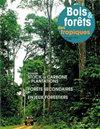Suitability of large-scale tree plantation models in Africa, Asia and Latin America for forest landscape restoration objectives
IF 0.6
4区 农林科学
Q3 FORESTRY
引用次数: 0
Abstract
Today, tree plantations play a crucial role in supplying wood and wood-based products. They supply almost half of global demand, as well as supporting a diversity of ecosystem services. In tropical and subtropical areas, where tree growth is optimum and large tracts of land are available, forest restoration is presented as one of the most effective strategies for climate change mitigation. For these reasons, large-scale tree plantations are being encouraged in Africa, Asia and Latin America. Based on a review of the literature and of public databases on forest plantations, we drew up a typology of large-scale tree plantations in Latin America, Africa and Asia using four criteria: the management objective (production versus protection), number of species planted (multi-species versus mono-species), origin of species (exotic versus indigenous) and management status (industrial companies, private smallholders, state). Our analysis identified seven main plantation types and reveals that the two most common types represent almost 60% of the total planted area: (1) private mono-species plantations using exotic species; and (2) public production-oriented mono/multi-species plantations of indigenous trees. Numerous experimental studies were conducted in the 1950s and 1960s with a wide range of tree plantation models. However, few were adopted by operators because the production rates and financial returns were considered low. The dominant tree plantation types are failing to meet most of the forest restoration objectives set out in the Bonn Challenge (i.e., productivity, carbon storage, biodiversity conservation, rural livelihoods). Alternative large-scale tree plantation models could be promoted by focusing on the other goods and services that plantations can provide. This could be achieved if more diverse stakeholders were involved in plantation design and management processes, and if appropriate technical, financial, and institutional incentives were developed.非洲、亚洲和拉丁美洲大型人工林模式对森林景观恢复目标的适宜性
今天,树木种植园在供应木材和木制品方面发挥着至关重要的作用。它们提供了全球近一半的需求,并支持多种生态系统服务。在热带和亚热带地区,树木生长最佳,有大片土地可用,森林恢复被认为是缓解气候变化的最有效战略之一。由于这些原因,非洲、亚洲和拉丁美洲正在鼓励大规模植树。在回顾文献和公共数据库的基础上,我们根据管理目标(生产与保护)、种植物种数量(多物种与单一物种)、物种起源(外来物种与本地物种)和管理状况(工业公司、私人小农、国家)四个标准,对拉丁美洲、非洲和亚洲的大型人工林进行了类型学分析。通过分析,我们确定了7种主要的人工林类型,并发现两种最常见的人工林类型占总人工林面积的近60%:(1)利用外来物种的私人单物种人工林;(2)以公共生产为导向的本土树种单/多种人工林。在20世纪50年代和60年代进行了大量的实验研究,采用了各种各样的植树模型。然而,由于生产效率和经济回报被认为很低,因此很少被运营商采用。主要的人工林类型未能满足波恩挑战中提出的大多数森林恢复目标(即生产力、碳储存、生物多样性保护、农村生计)。可以通过关注种植园可以提供的其他商品和服务来推广替代的大规模植树模式。如果更多不同的利益相关者参与种植园设计和管理过程,如果制定适当的技术、财政和体制激励措施,就可以实现这一目标。
本文章由计算机程序翻译,如有差异,请以英文原文为准。
求助全文
约1分钟内获得全文
求助全文
来源期刊

Bois et Forets Des Tropiques
FORESTRY-
CiteScore
1.50
自引率
16.70%
发文量
31
审稿时长
>12 weeks
期刊介绍:
In 1947, the former Tropical Forest Technical Centre (CTFT), now part of CIRAD, created the journal Bois et Forêts des Tropiques. Since then, it has disseminated knowledge and research results on forests in intertropical and Mediterranean regions to more than sixty countries. The articles, peer evaluated and reviewed, are short, synthetic and accessible to researchers, engineers, technicians, students and decision-makers. They present original, innovative research results, inventions or discoveries. The journal publishes in an international dimension. The topics covered are of general interest and are aimed at an informed international audience.
 求助内容:
求助内容: 应助结果提醒方式:
应助结果提醒方式:


